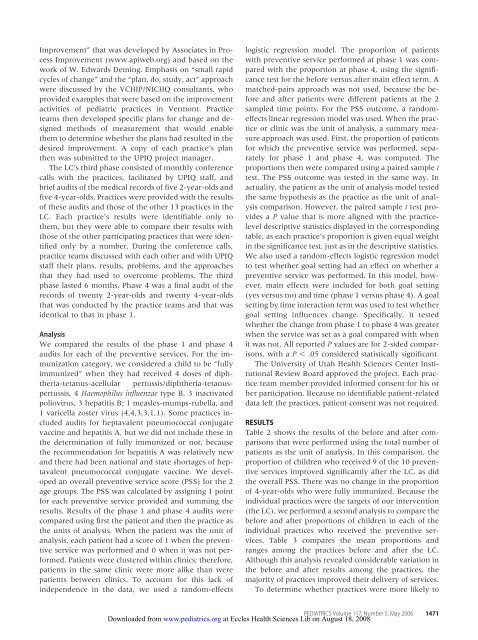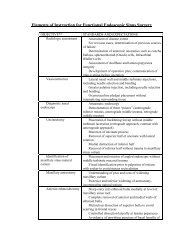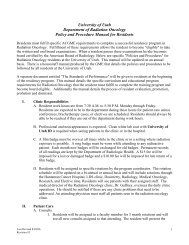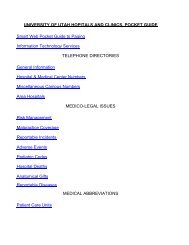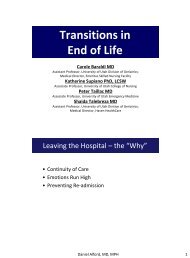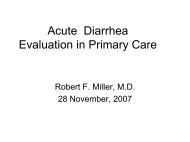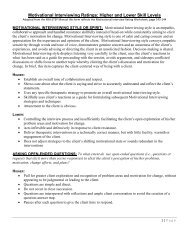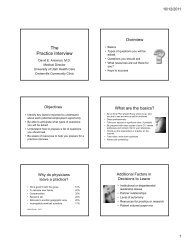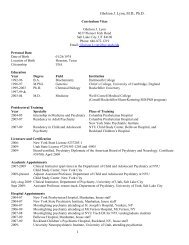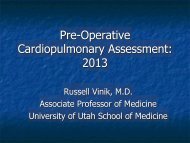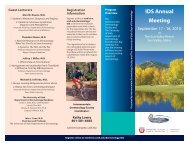Evaluation of a Learning Collaborative to Improve the Delivery of ...
Evaluation of a Learning Collaborative to Improve the Delivery of ...
Evaluation of a Learning Collaborative to Improve the Delivery of ...
Create successful ePaper yourself
Turn your PDF publications into a flip-book with our unique Google optimized e-Paper software.
<strong>Improve</strong>ment” that was developed by Associates in Process<br />
<strong>Improve</strong>ment (www.apiweb.org) and based on <strong>the</strong><br />
work <strong>of</strong> W. Edwards Deming. Emphasis on “small rapid<br />
cycles <strong>of</strong> change” and <strong>the</strong> “plan, do, study, act” approach<br />
were discussed by <strong>the</strong> VCHIP/NICHQ consultants, who<br />
provided examples that were based on <strong>the</strong> improvement<br />
activities <strong>of</strong> pediatric practices in Vermont. Practice<br />
teams <strong>the</strong>n developed specific plans for change and designed<br />
methods <strong>of</strong> measurement that would enable<br />
<strong>the</strong>m <strong>to</strong> determine whe<strong>the</strong>r <strong>the</strong> plans had resulted in <strong>the</strong><br />
desired improvement. A copy <strong>of</strong> each practice’s plan<br />
<strong>the</strong>n was submitted <strong>to</strong> <strong>the</strong> UPIQ project manager.<br />
The LC’s third phase consisted <strong>of</strong> monthly conference<br />
calls with <strong>the</strong> practices, facilitated by UPIQ staff, and<br />
brief audits <strong>of</strong> <strong>the</strong> medical records <strong>of</strong> five 2-year-olds and<br />
five 4-year-olds. Practices were provided with <strong>the</strong> results<br />
<strong>of</strong> <strong>the</strong>se audits and those <strong>of</strong> <strong>the</strong> o<strong>the</strong>r 13 practices in <strong>the</strong><br />
LC. Each practice’s results were identifiable only <strong>to</strong><br />
<strong>the</strong>m, but <strong>the</strong>y were able <strong>to</strong> compare <strong>the</strong>ir results with<br />
those <strong>of</strong> <strong>the</strong> o<strong>the</strong>r participating practices that were identified<br />
only by a number. During <strong>the</strong> conference calls,<br />
practice teams discussed with each o<strong>the</strong>r and with UPIQ<br />
staff <strong>the</strong>ir plans, results, problems, and <strong>the</strong> approaches<br />
that <strong>the</strong>y had used <strong>to</strong> overcome problems. The third<br />
phase lasted 6 months. Phase 4 was a final audit <strong>of</strong> <strong>the</strong><br />
records <strong>of</strong> twenty 2-year-olds and twenty 4-year-olds<br />
that was conducted by <strong>the</strong> practice teams and that was<br />
identical <strong>to</strong> that in phase 1.<br />
Analysis<br />
We compared <strong>the</strong> results <strong>of</strong> <strong>the</strong> phase 1 and phase 4<br />
audits for each <strong>of</strong> <strong>the</strong> preventive services. For <strong>the</strong> immunization<br />
category, we considered a child <strong>to</strong> be “fully<br />
immunized” when <strong>the</strong>y had received 4 doses <strong>of</strong> diph<strong>the</strong>ria-tetanus-acellularpertussis/diph<strong>the</strong>ria-tetanuspertussis,<br />
4 Haemophilus influenzae type B, 3 inactivated<br />
poliovirus, 3 hepatitis B; 1 measles-mumps-rubella, and<br />
1 varicella zoster virus (4,4,3,3,1,1). Some practices included<br />
audits for heptavalent pneumococcal conjugate<br />
vaccine and hepatitis A, but we did not include <strong>the</strong>se in<br />
<strong>the</strong> determination <strong>of</strong> fully immunized or not, because<br />
<strong>the</strong> recommendation for hepatitis A was relatively new<br />
and <strong>the</strong>re had been national and state shortages <strong>of</strong> heptavalent<br />
pneumococcal conjugate vaccine. We developed<br />
an overall preventive service score (PSS) for <strong>the</strong> 2<br />
age groups. The PSS was calculated by assigning 1 point<br />
for each preventive service provided and summing <strong>the</strong><br />
results. Results <strong>of</strong> <strong>the</strong> phase 1 and phase 4 audits were<br />
compared using first <strong>the</strong> patient and <strong>the</strong>n <strong>the</strong> practice as<br />
<strong>the</strong> units <strong>of</strong> analysis. When <strong>the</strong> patient was <strong>the</strong> unit <strong>of</strong><br />
analysis, each patient had a score <strong>of</strong> 1 when <strong>the</strong> preventive<br />
service was performed and 0 when it was not performed.<br />
Patients were clustered within clinics; <strong>the</strong>refore,<br />
patients in <strong>the</strong> same clinic were more alike than were<br />
patients between clinics. To account for this lack <strong>of</strong><br />
independence in <strong>the</strong> data, we used a random-effects<br />
logistic regression model. The proportion <strong>of</strong> patients<br />
with preventive service performed at phase 1 was compared<br />
with <strong>the</strong> proportion at phase 4, using <strong>the</strong> significance<br />
test for <strong>the</strong> before versus after main effect term. A<br />
matched-pairs approach was not used, because <strong>the</strong> before<br />
and after patients were different patients at <strong>the</strong> 2<br />
sampled time points. For <strong>the</strong> PSS outcome, a randomeffects<br />
linear regression model was used. When <strong>the</strong> practice<br />
or clinic was <strong>the</strong> unit <strong>of</strong> analysis, a summary measure<br />
approach was used. First, <strong>the</strong> proportion <strong>of</strong> patients<br />
for which <strong>the</strong> preventive service was performed, separately<br />
for phase 1 and phase 4, was computed. The<br />
proportions <strong>the</strong>n were compared using a paired sample t<br />
test. The PSS outcome was tested in <strong>the</strong> same way. In<br />
actuality, <strong>the</strong> patient as <strong>the</strong> unit <strong>of</strong> analysis model tested<br />
<strong>the</strong> same hypo<strong>the</strong>sis as <strong>the</strong> practice as <strong>the</strong> unit <strong>of</strong> analysis<br />
comparison. However, <strong>the</strong> paired sample t test provides<br />
a P value that is more aligned with <strong>the</strong> practicelevel<br />
descriptive statistics displayed in <strong>the</strong> corresponding<br />
table, as each practice’s proportion is given equal weight<br />
in <strong>the</strong> significance test, just as in <strong>the</strong> descriptive statistics.<br />
We also used a random-effects logistic regression model<br />
<strong>to</strong> test whe<strong>the</strong>r goal setting had an effect on whe<strong>the</strong>r a<br />
preventive service was performed. In this model, however,<br />
main effects were included for both goal setting<br />
(yes versus no) and time (phase 1 versus phase 4). A goal<br />
setting by time interaction term was used <strong>to</strong> test whe<strong>the</strong>r<br />
goal setting influences change. Specifically, it tested<br />
whe<strong>the</strong>r <strong>the</strong> change from phase 1 <strong>to</strong> phase 4 was greater<br />
when <strong>the</strong> service was set as a goal compared with when<br />
it was not. All reported P values are for 2-sided comparisons,<br />
with a P .05 considered statistically significant.<br />
The University <strong>of</strong> Utah Health Sciences Center Institutional<br />
Review Board approved <strong>the</strong> project. Each practice<br />
team member provided informed consent for his or<br />
her participation. Because no identifiable patient-related<br />
data left <strong>the</strong> practices, patient consent was not required.<br />
RESULTS<br />
Table 2 shows <strong>the</strong> results <strong>of</strong> <strong>the</strong> before and after comparisons<br />
that were performed using <strong>the</strong> <strong>to</strong>tal number <strong>of</strong><br />
patients as <strong>the</strong> unit <strong>of</strong> analysis. In this comparison, <strong>the</strong><br />
proportion <strong>of</strong> children who received 9 <strong>of</strong> <strong>the</strong> 10 preventive<br />
services improved significantly after <strong>the</strong> LC, as did<br />
<strong>the</strong> overall PSS. There was no change in <strong>the</strong> proportion<br />
<strong>of</strong> 4-year-olds who were fully immunized. Because <strong>the</strong><br />
individual practices were <strong>the</strong> targets <strong>of</strong> our intervention<br />
(<strong>the</strong> LC), we performed a second analysis <strong>to</strong> compare <strong>the</strong><br />
before and after proportions <strong>of</strong> children in each <strong>of</strong> <strong>the</strong><br />
individual practices who received <strong>the</strong> preventive services.<br />
Table 3 compares <strong>the</strong> mean proportions and<br />
ranges among <strong>the</strong> practices before and after <strong>the</strong> LC.<br />
Although this analysis revealed considerable variation in<br />
<strong>the</strong> before and after results among <strong>the</strong> practices, <strong>the</strong><br />
majority <strong>of</strong> practices improved <strong>the</strong>ir delivery <strong>of</strong> services.<br />
To determine whe<strong>the</strong>r practices were more likely <strong>to</strong><br />
PEDIATRICS Volume 117, Number 5, May 2006 1471<br />
Downloaded from<br />
www.pediatrics.org at Eccles Health Sciences Lib on August 18, 2008


